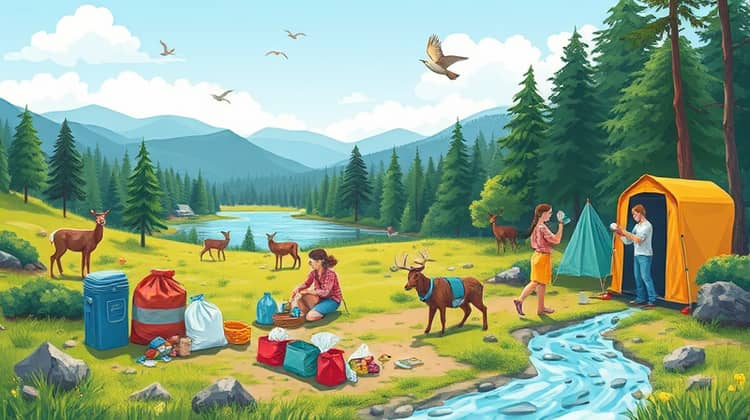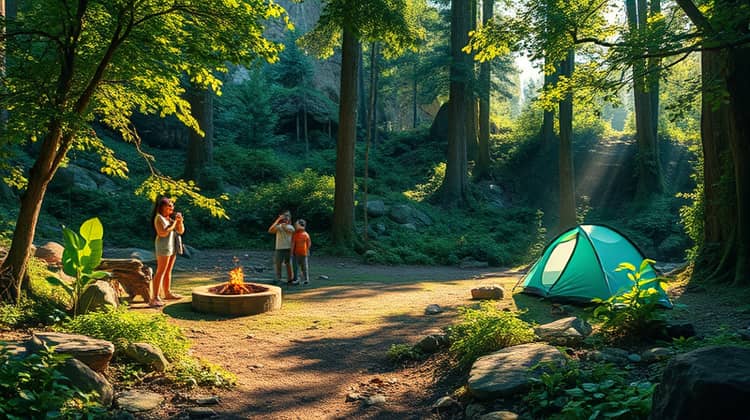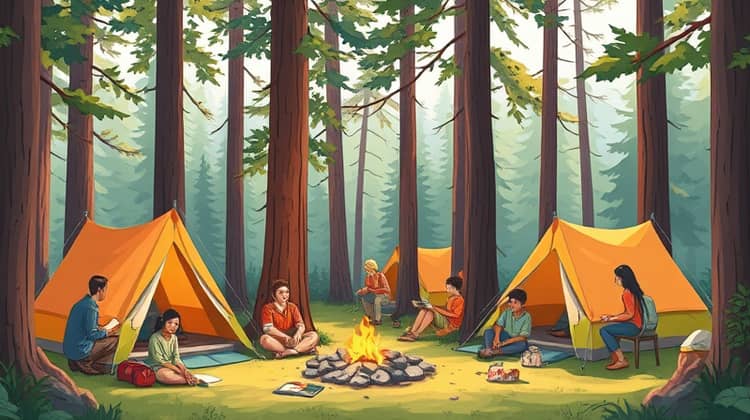Camping is a wonderful way to experience the great outdoors, connect with nature, and create lasting memories with friends and family. However, it comes with a responsibility to protect the environments we cherish. This article highlights best practices for Leave No Trace camping, ensuring that our impact on nature is minimal and the beauty of the wilderness remains intact for future generations.
Understanding and following Leave No Trace principles not only safeguards our natural spaces. It also fosters a sense of stewardship and respect towards the ecosystems and wildlife that inhabit them. By embracing these practices, we can enjoy our outdoor adventures while also being conscious of our environment.
Before embarking on a camping trip, it is crucial to educate ourselves about Leave No Trace principles. This proactive approach ensures that we are prepared to mitigate our impact during our outdoor outings.
1. Plan Ahead and Prepare

Proper planning is vital in Leave No Trace camping. Researching your destination can help you understand specific regulations and guidelines that may apply to the area you plan to visit. Being informed allows you to prepare adequately and pack responsibly, minimizing your environmental footprint.
Before you go, consider factors like the weather, camping restrictions, and local flora and fauna. Understanding these elements can enhance your camping experience while ensuring safety for both you and the ecosystem.
Preparation also includes making sure you have the right gear and knowledge needed for the terrain you'll encounter. Proper equipment can help you avoid damaging the environment, making it easier to follow Leave No Trace principles during your trip.
- Research your camping destination and its Leave No Trace regulations.
- Make a checklist of essential gear to minimize unnecessary items.
- Plan your meals to reduce waste and ensure you have the appropriate storage.
A well-prepared camping trip involves considering not just your needs but also those of the environment. Proper planning can help protect the natural beauty you are going to enjoy.
Remember that your actions, from choosing a campsite to the food you bring, can have significant impacts on the ecosystem. Always aim to preserve the wilderness.
2. Travel and Camp on Durable Surfaces

One of the simplest ways to practice Leave No Trace is by traveling and camping on durable surfaces. This includes established trails, campsites, and areas that are already impacted to minimize damage to the environment.
Choosing durable surfaces not only protects the vegetation but also reduces soil erosion and prevents the creation of new trails. Many national and state parks have designated sites that provide the least impact on their natural surroundings.
As campers, it's our responsibility to stick to these established paths and sites when setting up camp to help preserve the pristine places we love to visit.
- Use existing trails to avoid creating new paths.
- Camp at least 200 feet away from lakes and streams to protect shorelines.
- Choose campsite locations on hard surfaces, like gravel or dry grass.
3. Dispose of Waste Properly

Proper waste disposal is crucial in Leave No Trace camping. It is essential to carry out everything you bring in, plus any waste left by previous visitors. This helps ensure that natural spaces remain clean and unpolluted.
Responsible disposal of waste goes beyond just trash. It includes managing human waste, which can have significant impacts on local freshwater sources and wildlife if not handled appropriately.
- Pack out all trash, leftover food, and personal items.
- Use biodegradable soap for dishwashing and dispose of wastewater at least 200 feet from water sources.
- Dispose of human waste in a designated toilet or use a portable toilet.
By adhering to these guidelines for waste disposal, we can significantly reduce our impact on natural areas. This practice helps maintain the ecological balance and protects wildlife and plant species.
Remember that how you manage your waste plays a critical role in preserving the beauty of our landscapes and the health of our ecosystems.
4. Leave What You Find

When camping in nature, it is important to appreciate and leave behind all the natural features you encounter. The principle of leaving what you find urges campers to not disturb the environment or remove any natural or cultural artifacts, such as rocks, plants, or historical landmarks.
Taking only photos and leaving only footprints is a great mantra to follow. This helps maintain the natural beauty of the landscapes and respects the habitats of various species.
- Leave rocks, plants, and other natural features as you found them.
- Take only photos and memories; do not collect souvenirs from nature.
- Avoid creating new fire rings by using established fire pits.
Leaving what you find helps ensure that others can enjoy the same beauty you experienced. It preserves the integrity of ecosystems and promotes conservation efforts.
Enjoy the wonders of nature by observing them rather than altering them. Every action contributes to the preservation of these areas.
5. Minimize Campfire Impact

Campfires can be a delightful addition to a camping experience, but they can also have lasting impacts on the environment. Minimizing campfire impact is an essential aspect of Leave No Trace camping.
To enjoy campfires responsibly, it’s vital to follow regulations regarding fires in your camping area. This helps prevent wildfires and protects local vegetation.
- Use a camp stove for cooking instead of building a fire.
- Utilize established fire rings and keep fires small.
- Burn only wood that is dead and down; never damage live trees for firewood.
By following these simple practices, we can enjoy the ambiance of a campfire without unnecessary damage to our surroundings. In some cases, it may be best to avoid campfires altogether, especially in dry or sensitive areas.
Leave No Trace camping encourages us to respect the land, ensuring that what may seem like a small action doesn't lead to larger environmental consequences.
6. Respect Wildlife

Respecting wildlife is a core aspect of Leave No Trace camping. Understanding how our actions affect animals and their habitats is essential to ensure their continued survival and well-being.
Observing wildlife is a beautiful part of camping, but it’s crucial to prioritize their safety. By respecting their space and habitats, we ensure a more successful and less stressful encounter for both you and the wildlife.
- Observe wildlife from a distance; do not approach or feed animals.
- Store food securely to minimize interactions with wildlife.
- Leave wildlife and their habitats undisturbed.
Preventing conflicts with animals often relies on simple actions such as proper food storage and avoiding feeding them. This protects both human and animal life.
Remember that wildlife are not pets; admire them without impacting their natural behaviors.
7. Be Considerate of Other Visitors

Camping is a wonderful social experience, but it’s also important to be considerate of fellow campers. Noise levels, sharing resources, and respecting other visitors can contribute significantly to a positive camping experience for everyone.
Understanding the rights of others and ensuring that everyone enjoys their time in nature is crucial. A little courtesy towards fellow campers can help maintain the peace and natural beauty.
When you are considerate, you help to foster an encouraging community around camping and outdoor activities.
- Keep noise levels down; avoid loud music or voices.
- Respect other visitors' space; do not intrude on their campsites.
- Follow all park regulations regarding group sizes and noise.
Being considerate helps create a more enjoyable experience for everyone involved. Good camping etiquette contributes to a friendly atmosphere and encourages people to come back to enjoy nature.
A little mindfulness can go a long way to ensure that everyone can enjoy the great outdoors together.
Conclusion

In conclusion, Leave No Trace camping is about more than just minimizing our impact on the environment; it's about fostering respect for nature and those who share it with us. By embracing these principles, we contribute to the preservation of our cherished landscapes for generations to come.
Camping can be a fulfilling experience when we are conscious of our surroundings and the effects of our actions. Each small step adds up to create a significant impact, making our nature trips sustainable and enjoyable for everyone.
Let us aim to be responsible stewards of the land, encouraging future visitors to tread lightly and appreciate the beauty our planet holds.














